Stupidity by our elected officials.
Governor Fitial wrote to President Bush saying NO to a national marine monument in the Marianas Trench at Uracas,
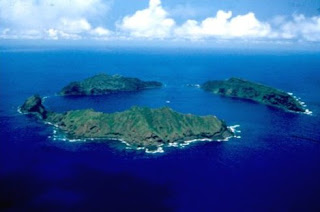
Maug,
and Asuncion.
He spoke of the longstanding dispute between the U.S. and CNMI governments over the ownership and management of submerged lands around the Northern Marianas.
Our
CNMI students participate in Mock Trial, write essays and debate over legal issues, and probably know more than our Governor about the meaning of a court's decision. It's called "finality" --that attribute of a court decision when all appeals are exhausted. And it means that the matter is SETTLED, OVER, FINITE, DONE, RESOLVED, and FINAL. The
CNMI litigated and lost the submerged lands issue. There is no longer a dispute between the U.S. and the
CNMI about this matter. And the Governor's foolish adherence to a claim that has been lost has no merit.
It certainly isn't a reason to reject a proposal to save our oceans and promote conservation before we've ruined beyond redemption the entire globe.
He is also concerned that the designation would restrict the indigenous people's ability to fish and conduct related activities in the proposed site.
Why is it that we are concerned that conservation limits our activities? Of course it does. That's its purpose. We need those limits because our natural resources are limited.
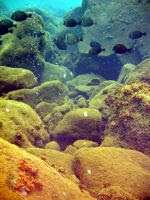
In the Pacific Ocean at
Maug.
If we don't limit ourselves, we will deplete our natural world.
“We rely on fishing as a source of food and jobs.
We do not depend on fishing in the waters around the three northern-most islands for anything. We're not fishing there. Who has jobs that relate to industry or fishing around
Uracas,
Maug, or Asuncion that would be lost by creation of a marine sanctuary?
No one. The creation of the sanctuary can be done to allow anyone who is currently invested in fishing in those waters a time period to recoup their investment and withdraw from fishing there. In Hawaii, the few fishing interests in the area that was eventually protected by the marine monument were given 5 years to keep fishing.
But again, I ask, who is fishing around
Uracas,
Maug, and Asuncion?
Right now, according to Pete A. in his State of the Commonwealth address, there is satellite evidence that these waters are being poached. The
CNMI is not protecting anything, and not
benefiting either. Better to protect the area than let it be devastated by poaching and unrestricted use.
Those who live in the CNMI have no interest in ceding their cultural heritage to the federal government under the auspices of environmental protectionism,” he said.
Conserving our marine environment is not ceding a cultural heritage. Letting
WESPAC and its henchmen get to our Legislators and officials to vote against protecting our marine environment is ceding our cultural heritage.
The most vocal opposition to the marine sanctuary has come from John
Gourley, who is on the advisory panel for
WESPAC.
WESPAC is a federal agency that promotes fishing--and right now, the FISHING interests are in control of our oceans. Their financial interest is to take as much as they can get away with, and they have caused tremendous damage to the world's oceans, as reported in numerous scientific and popular journals and newspapers.
This commercial fishing is NOT our cultural heritage, where islanders took small amounts of fish for what they needed on any given day. Now we have fishing vessels scooping up everything, and throwing back into the ocean dead creatures--the "by-catch" they don't want, keeping the haul that is commercially viable for them.
This commercial fishing is not the
CNMI's cultural heritage. This harm to the ocean is not the
CNMI's cultural heritage. This failure to respect the marine environment is not our cultural heritage.
The governor argued that the Commonwealth is looking at fishery as an economic growth engine to replace the declining garment and tourism industries. He said the loss of about 115,000 square miles of ocean area due to inclusion in a national monument would significantly impact this economic effort.
Why is our Governor embracing this type of harm and speaking of it as our cultural right? Didn't we learn anything from the problems with the garment industry? When you choose as your livelihood something that hurts people or the world, it's not a sound basis for an economy. "Our" garment industry brought us shame and a horrible world image, bad press, and a scarred moral compass. The Governor may have gotten rich off it, but that doesn't mean it was good for the
CNMI.
Tourism, on the other hand, invites people to share our islands, our culture, our lives. It offers respite and recreation. This is a sound economic choice.
Our tourism industry is declining, but we can turn that around with good decisions. A healthy commitment to a clean and conserved natural environment would be a huge step in the right direction.
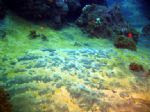
Volcanic sulfur bubbles at
Maug.
Instead, our Governor wants to now promote a joint venture with
WESPAC? Commercial fishing where we rape our waters of what little is left? Do we really think that commercial fishing, as it presently exists, is going to improve our world? Is it a sound basis for our economy?
No. At present, it's depleting our oceans.
Why do we turn a blind eye to the damage these fishing
interests and the U.S. government's
WESPAC agency is doing? Because there are liars and cheats among us, people willing to twist the facts and prey on fears and prejudices to get what they want, to keep their pockets full while emptying us of our world's natural resources.
If that's not what is meant by commercial fishing, if commercial fishing insists that it believes in protecting the oceans, too--then let it support a marine sanctuary. Why can't we protect 1/3 of the ocean around the
CNMI with a marine sanctuary? Isn't 2/3 of the
EEZ enough for fishing?
One of the most important protections the globe has is from the ocean's coral
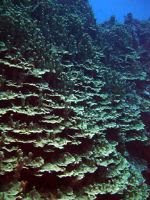
Coral layers at
Maug.
--more significant than
rain forests. And our ocean health depends on complete and healthy
eco-systems. Why do we not want to protect 1/3 of our waters? That may not be enough, but at least it's something! We have a chance to do our part. Let's do it!
Further, the governor said, Hawaii's experience with its marine monument showed a lack of procedural safeguards to ensure public involvement and environmental review during the designation process.
Now that sounds like a straight-out lie.
What do you see happening here in the
CNMI? Angelo
Villagomez, on behalf of Pew Charitable Trust, is going out getting comments, talking with people. We already have public involvement.
In the Hawaii process, Angelo reported that there were hundreds of thousands of comments taken, both before and after the designation--comments that were considered, comments that helped shape the eventual final project.
Instead, it is the Governor who is shutting down the process, not letting us be heard!
Press secretary Charles P. Reyes Jr. said that federal enforcement funding may be a concern. He said the U.S. Coast Guard was not given any additional money or resources to extend patrols in Hawaii's monument area, and a similar scenario is likely if a Northern Marianas monument is created.

If this were true, how would it weigh against a marine sanctuary? Would we be worse off? NO! NO! NO! The Coast Guard patrols now, and the Coast Guard patrols after a designation of the area as a marine sanctuary. We'd like it to be better; we'd like it to have more money; but that is no reason to say we don't want to protect this marine environment!
“The people of the CNMI and their elected leaders do not want an outside group to permanently force a decision on them without their consent. This decision is too important to be left to Pew and their supporters. The people of the CNMI must decide if they want to give up a resource forever and forego all other opportunities or developments. This is democracy.”
We don't want an "inside" group permanently forcing a decision on us without our consent, either! This is a democracy! How many public hearings has the Governor or the Legislature held on this issue? HOW DARE YOU SPEAK as if you know what the public wants when you have done NOTHING to find out! The decision is too important to be left to Charles Reyes Jr. or Governor
Fitial.
Please make the stupidity stop. Make corruption stop. Make the devastation of our natural world stop!
Prevent
WESPAC from doing further damage. Wrest these waters from their control and protect the
EEZ around
Uracas,
Maug, and Asuncion by making them into a marine monument!
Photos from MARAMP, the CNMI DPL, and Sarah Poznay.
I like to analyze analogies used for and against proposals. A good analogy can make an argument stronger. A poor analogy loses the day.
There have been some different analogies used about the proposal for a national marine monument:
John Gourley analogized the ocean to a bank, and the national marine monument to a bank policy that let us look at our wealth but not have access to it in times of need. As I mentioned previously, this analogy is oh so wrong because 1) the world is not an unlimited bank from which we can withdraw endlessly; 2) if it is a bank, we are not the "depositors" in the bank and thus don't have the right to withdraw; and 3) even with banks, not having policies that regulate what can be withdrawn will result in bankruptcy.
Besides there is an underlying fallacy in the bank analogy. It presupposes that the national marine monument closes the door to withdrawing needed resources. Here's a map taken from The Saipan Blog.
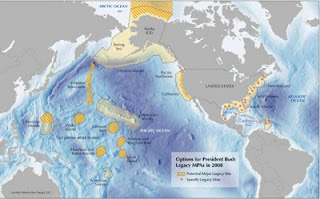
If the ocean is a bank, then the withdrawal doors look very wide open. Even if ALL of the yellow zones became protected areas, there is still a lot of ocean left to withdraw from.
Another analogy:
In today's letter to the editor , Brad Doerr affirms that the CNMI Legislature was right to go slowly, be cautious, look both ways before crossing the street on the Pew proposal for a National Marine Monument. I think that Mr. Doerr was trying to be conciliatory and diplomatic, trying to get the Legislators to come back to sanity and recast their votes in favor of the National Marine Monument.
But the analogy doesn't work for me. As I view it, we're already standing in the middle of the road. Traffic is whizzing around us, killing our oceans and warming our globe. Pew Charitable Trust is like a kindly safety guard who's rushed out to guide us safely to the side of the road to protect our life. And the CNMI, like a foolish, stupid, immature child, is saying "no, I don't have to move if I don't want to."
Smash, crash. We're all doomed.
Pew Charitable Trust, for their part, have gone off to rescue someone smarter, someone who sees the danger and wants the rescue. Someone who might even say thank you when they're safely on the side of the road.
This is a short, off-the-cuff response:
Despite what Mr. Gourley says, the submerged lands issue is resolved. Roughly speaking, the submerged lands around our islands belong to the U.S. as an "exclusive economic zone" under U.S. law because no other alternative was reserved or defined in the Covenant. This is based on U.S. law, the same U.S. law applies here as it applies to all of the states.
Mr. Gourley's argument: the CNMI is trying to get the U.S. to give it some of the submerged lands that are part of the U.S. eez. If we have a National Marine Monument, there'll be less for the CNMI to beg from the U.S. (Let's keep the coffers open.)
My response. This is not an argument against protecting the natural habitat. It is the politics of control. If it's a good idea to have a protected zone, then it's a good idea whether the U.S. does it or the CNMI does it. And frankly, it's better for the CNMI to have the U.S. pay for it.
From my perspective, this argument (and all of Mr. Gourley's arguments) are based on a desire to keep the ocean open to commercial interests. Mr. Gourley would like the least amount of regulation between him and his clients and the natural world. This would make it easier to TAKE and TAKE and keep TAKING ocean resources.
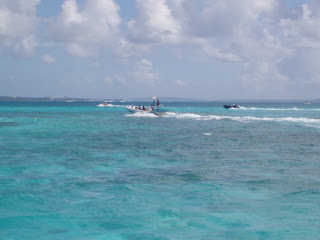
My guess is that businesses who have little or no respect for the environment would find it easier to abuse the environment under CNMI control than under U.S. control (I say this, given the CNMI's poor performance at regulating any government activity). So Mr. Gourley's wanting the CNMI to have control isn't in the interests of the CNMI, but rather in the interests of the businesses who will then abuse our natural resources.
The CNMI doesn't have the money, the manpower, or the know-how at its ready disposition to take necessary action to protect our marine resources, especially at the remote outpost of our three northernmost islands.
Mr. Gourley's argument: The natural world is a bank and we can tap its resources until it goes bankrupt. It's somehow wrong to deprive us from doing that.
Mr response: We have to protect our environment. We are not depositors into the bank, and we can't keep taking out resources. It (our natural world) will go bankrupt.
We need zones that are completely free from humanity's rapacious appetite. Perhaps another analogy for the National Marine Monument (rather than a bank that won't let anyone withdraw resources) is the DMZ. If we want an end to war, we have to start with peace somewhere. Mr. Gourley would have us fighting with no DMZ, no peace, no place of respite. Our marine life needs a free zone, a respite where it can escape the war against it.
Mr. Gourley argues for on-going "protection" of our marine resources by Wespac and the National Marine Fisheries Service (NMFS). This essentially means no protection.
NMFS has failed to do its job of protecting marine life in Hawaii waters, See Report on NMFS ; in the Atlantic; See Audobon Society sues; in the Gulf of Mexico, See Red Snapper depeletion, and in the Pacific Northwest NMFS fails alongside Oregon agency .
I previously noted an on-going investigation into allegations against Wespac, another federal agency that has demonstrated its willingness to hear only the commercial fishing industry's voice in the discussion on marine species regulation.
There is no good reason for the public to have confidence in either of these agencies when it comes to protecting our precious marine environment. The public record clearly shows that they are more interested in helping commercial fishing interests than in enforcing laws that ensure the vitality of our limited and dwindling marine life.
The National Marine Monument, with the shift to NOAA, promises a much better chance of real environment conservation.
And that's a good thing.
Letters to the Editor
Friday, April 11, 2008
Reason 1 why I oppose the PEW (It's Pew Charitable Trust, not PEW.) National Monument. It would be a Marine National Monument.
So there are no misunderstandings about my purpose, I must first start out stating that the following comments are my own personal opinions and I am not representing any organizations. Additionally, I am not being paid nor am I receiving any compensation for writing this letter or subsequent letters to the editor on this topic. But you do have a personal financial stake. You operate a business, Micronesian Environment Services, that benefits from open access to limited natural resources. Must be the humidity. The more protections for those resources, the harder it is for you to "help" your clients get access to our precious natural resources .
My opinion on the NMI Marine National Monument (PEW Monument) being proposed by the PEW Foundation is based on my long-term involvement in the marine science and environmental regulatory fields and my personal belief in supporting sustainable fisheries programs.
As background, I was first introduced to the PEW Monument idea during the Mariana Islands Nature Alliance Strategic Planning Session held on Nov. 17, 2007 at Fiesta Resort. Those in attendance were told by PEW that they had already approached White House staff about the NMI Monument and President Bush was ready to sign the Presidential Proclamation as soon as PEW could show support from the CNMI government and residents. PEW was offering to provide operating expenses to MINA in the form of grants in exchange for their active participation in promoting and selling the PEW Monument idea to the people of the CNMI. The MINA Board declined PEW's generous offer.
I attended a second, more formal PEW presentation on March 26, 2008, where the same concept was presented, complete with a PowerPoint show, colorful glossy handouts and various fact sheets providing general information about the northern islands. And finally, I carefully reviewed the PEW letter to Governor Fitial, dated Dec. 20, 2007, that outlined their proposal to create a very large no-take marine protected area in the Northern Mariana Islands EEZ, and an Internet investigation into both the PEW Foundation and the Northwestern Hawaiian Islands Marine National Monument (NWHI Monument) controversy. I would like to think that I have done my homework in attempting to fully understand the issues and resulting long term repercussions should President Bush designate over a third of the entire CNMI EEZ (115,000 square miles) as a National Monument.
My wish is to write a series of letters to the editor that will attempt to reveal certain issues that my not be apparent from listening to the polished PEW presentation. My purpose is to provide background information so interested people will be able to ask pertinent questions on issues important to the community. Please remember, the real stakeholders in this environmental political game are the people of the CNMI.
I have serious reservations on all the economic benefits that PEW is touting about the Monument and will address them in later letters. Meanwhile, I hope everyone understands that the PEW Foundation cannot guarantee the CNMI anything. They are simply a Washington DC-based third party expeditor What does this mean? Pew Charitable Trust is based in Philidelphia, PA, not D.C. They are a world-wide CHARITABLE/NON-PROFIT organization. trying to sell the CNMI a product that they themselves will have very little (or nothing) to do with once the Presidential Proclamation has been inked. Who will ultimately pay for the PEW Monument long after the PEW Foundation leaves the CNMI? We will, of course. I believe this is false. The Marine National Monument would be a joint federal and CNMI-managed protected area. The federal government would bear most of the costs. As noted in the letter from Pew Charitable Trust to Governor Fitial: "The economic opportunities created through designation of a large Marianas Trench Marine Monument are real. As the principle federal agency involved, the National Marine Sanctuary Program would undertake a management plan in conjunction with the CNMI government."
With that said, I believe the overall costs (costs are not necessarily limited to money) to the people of the CNMI are too high. Therefore, I completely oppose the PEW NMI Marine National Monument, Mariana Trench Marine Sanctuary, National Park of the Sea, or whatever name PEW is calling it this week. Pew Charitable Trust calls its overall project "Ocean Legacy." The naming of the Marine National Monument in the CNMI would, of course, need NMI input.
REASON 1
Designation of the PEW Monument will permanently ban all commercial, recreational and subsistence fishing activities to U.S. citizens Excuse me-all people, businesses, etc. not just U.S. citizens within Monument boundaries, an area encompassing 115,000 square miles. This will be accomplished by changing the existing resource management structure from that of promoting a sustainable fishery approach to a “no take” approach that prohibits virtually all extractive uses within Monument boundaries. There are reasons to create no-take, protected zones in our oceans. The "existing resource management structure" is, unfortunately, corrupted by the excessive interests of commercial fishing. For example, WESPAC is under investigation for using federal money to lobby state legislatures on behalf of fishing interests. Honolulu Advertiser reports on up-coming GAO investigatin of WESPAC. Even a cursory glance at the recently reported composition of WESPAC's nominated representatives shows a lopsided weighting of community voices on behalf of fishing (commercial, tourist, and gasoline enterprise) interests, with no environmental interests represented. Saipan Tribune 4/15/2008
Based on management measures promulgated by the NWHI Monument, indigenous people will very likely be allowed to fish for sustenance purposes (not to be confused with subsistence fishing which will be outlawed) within Monument waters, provided the (fishing) activity is included as a term or condition on the federal permit that must be first obtained from the National Marine Sanctuary Program (NOAA/NOS), or its regulatory equivalent. Interestingly, Monument regulations require all fish caught in Monument waters to be eaten within the boundaries of the Monument. Oh, and don't forget to turn in your catch report to the Monument management authority on the fish that was eaten!
JUSTIFICATION
Presently, marine resources within the federal waters of the CNMI EEZ (0 to 200 miles) are being jointly managed by two federal resource management entities; the Western Pacific Regional Fishery Management Council (Council) and the National Marine Fisheries Service (NMFS). Their approach to resource management is to support sustainable fishing practices in accordance to various federal laws (i.e., Magnuson (Stevens) Fishery Conservation and Management Act, Sustainable Fisheries Act, Endangered Species Act, National Environmental Policy Act, etc.). Both of these governmental entities also promote and embrace active participation in developing appropriate resource management measures from those who know the resources the best-the stakeholders. One might say "mis-managed." As noted above, the only "stakeholders" invited to the WESPAC table are fishing interests, and not the rest of us. Keep reading.
If the PEW Monument becomes a reality, the existing resource management authorities (i.e., the Council and NMFS) would be replaced immediately with another federal management agency within NOAA: the National Marine Sanctuary Program under the National Ocean Service. In contrast to the existing sustainable management approach, a resource management approach of no extractive uses will be implemented by the National Marine Sanctuary Program. This federal action is permanent and commercial, recreational, and subsistence fishing activities in approximately 115,000 square miles of CNMI waters will become a memory. But the fish will not become a memory--they'll be there for our future generations to see, know, study, appreciate.
In response to the above reality, PEW is quick to point out that indigenous islanders would be allowed to fish in Monument waters, just as the native Hawaiians are allowed to fish in the NWHI Monument. While this is a true statement, it is not telling you the whole story.
Regulations for the NWHI Monument (FR Vol. 71, No. 167; pages 51134-51142) require Monument visitors, including indigenous Hawaiians, to first obtain a federal permit that would allow access to NWHI Monument waters. Permitting is getting a license. It's not a serious hurdle. For example, a permit could be issued for the purpose of practicing various traditional or cultural activities in the NWHI Monument.
In order to fish in Monument waters, one must have fishing activities added to the permit as a term or condition (’404.11(h); page 51139). Sustenance fishing will only be authorized if the activity is “incidental to an activity permitted under this part” (’404.3; page 51137). My understanding is that permits will not be issued to those persons that wish to travel to the Monument for the sole purpose of fishing.
If one actually does receive a permit to sustenance fish, the visitor would be required to eat any fish caught in Monument waters within the Monument boundaries (’404.11e (5)). In simplest terms, no marine resources (i.e., fish and other edible marine life) can be taken from the Monument and distributed to family, friends, or community members back on their home island. And, should you be granted permission to actually eat a fish from the Monument, you will likely be required to submit a catch report to the Monument management authority documenting your eating event (see ’404.11(h); page 51140). There are benefits to requiring fishing permits and reports. They create 1) better data for managing fish populations; 2) a means to give a voice to recreational and cultural fishermen, and not just commercial fishing interests; and 3) possible revenues from licensing, and from any taxes on fishing-related activities. Compare: On requiring licensing under the Magnuson Stevens Fishery Management and Conservation Act.
The permanent ban on commercial fishing activities will detrimentally affect the CNMI's newest commercial fishing business venture that has already invested a substantial sum of money in infrastructure development on Rota and bringing two fishing vessels to the CNMI. The Hawaii National Monument allowed existing commercial enterprises a 5 year time-period to continue fishing in the new National Monument waters, as a means of recouping their investments. The same could be done here. Do we really wnt to scuttle a project that protects our ocean's resources for ALL people, just because of ONE commercial fishing venture? Creation of the PEW Monument will seriously inhibit the development of any future sustainable fishing industries as it will decrease the fishable area within the CNMI EEZ by 33 percent. This will not create a hardship on people of the CNMI. Few individuals or families can afford the cost of gasoline and the time it takes to travel to the three northernmost CNMI islands and fish.
So, what does the PEW Foundation really want? Simply put, they want 33 percent of our EEZ to be designated as a no-take National Monument so they can credit their Ocean Legacy Project for creating another large Marine Monument and help President Bush put another notch on his environmental bedpost to bolster his legacy as the ”Ocean President”. Not really. They want to create a National Marine Monument around the CNMI's three northernmost islands so that we can all protect our ocean's resources and have a beautiful place to visit. Working in concert with the President to designate the PEW Monument in the Mariana Islands before he leaves office is not about science-based conservation, but U.S. mainland politics. How could this help President Bush's politics? He has nothing to gain. It just might be the one time he's figured something out right.
Though it may surprise our paid PEW lobbyist, the opposing forces grow larger and stronger every time a presentation is made. PEW cannot fool everyone with their rhetoric and empty promises. They are not trying to fool anyone. They are holding open sessions, inviting comment, and trying to work together to sustain our environment.
What are you, Mr. Gourley, trying to protect?
1. The existing control by WESPAC, with it's hand-in-hand relationship with commercial fishing.
2. A "sustainable fishing" system, rather than a no-take protected environment system. But we're learning that "sustainable" fishing, with its focus on one species of fish at a time, is wrongly weighted in favor of over-taking and over-fishing, while our environment suffers. There is mounting evidence that the WESPAC -Magnuson-Stevens Act focus of species-by-species protection isn't working, and that a larger, global focus on ocean health would be a better approach. No take zones are important and helpful to environmental protection.
3. Your own interests in offering services to help others use or abuse our limited natural resources.
John Gourley
Navy Hill, Saipan
Governor Benigno R. Fitial and Lt. Governor Timothy Villagomez have announced their intention to seek another term in office.
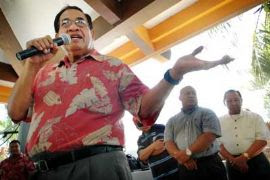
Their last election's slogan was "BETTER TIMES." Any one who's been living in the CNMI can attest to the failure of that promise. Personally, I'm not sure I can take much more "better times."
On the other hand, the Pew Charitable Trust has a great benefit to offer the CNMI, with a marine sanctuary protecting the waters-i.e. the Marianas Trench-- around three of our northern islands (Maug, Asuncion and Uracas). I've seen programs on PBS sponsored by the Pew Trust. Their web-site shows them to be a well-established and beneficial organization. Their work is designed to help the environment, including all people within it.
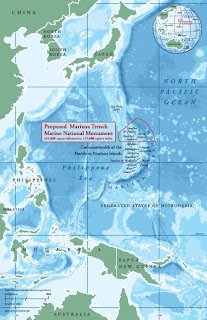
How could we get so lucky?
I mean, this is working in Hawaii, at the world's largest marine conservation habitat in the world. In Hawaii, they navigated sticky issues like commerical fishing, with a phase out over time as a concession to fishing interests, an exception for traditional subsistence Hawaiian fishing in recognition of the culture, and an exception for scientific research fish collection. They even got President George W. Bush's full support.
So we could have this happen here! Save our environment. Create a larger scientific community with money and research coming in. Protect our indigenous rights. All funded by the Pew Trust!
Aahh, BUT--- how could we have an Administration foolish enough to turn down this opportunity? What could explain the recent failure of our Administration to even meet with the people from the Pew Trust to hear their proposal? Because this is what's happening now.
Perhaps because the Pew Charitable Trust is an honorable organization? Offering no opportunity for kickbacks? no personal benefits? Am I too cynical? Are there real reasons to completely ignore this type of suggestion?
You can follow the unfolding story at Angelo's blog. The comments at Lil Hammerhead's show some nasty opposition to the proposal, but I'm still waiting for rational, logical dialogue on the merits of the proposal. I'd like to hear about research about current use and objectives/goals for fish conservation from WESPAC. What would the true impact be? As Cinta says here, give Pew a chance. [Her rational approach raises my hope.]
Whatever the relative merits of the proposal, at least we should honestly investigate and discuss it. The President of the U.S. spent more than an hour of his time watching a video and learning about the Hawaiian marine sanctuary project. Is our Governor busier than the President of the U.S.? Are we in the CNMI less deserving of this type of investment so that we must run away from it? Or do we, too, honor our islands, our waters, our people and culture, and welcome others who will help us on such a course?
For me, it's all about real "better times."



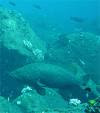









I hope you sent this to both newspapers.
I'm not even surprised. Fitial is elevating his game to Bush level incompetence.
Jeff,
I think it's a tried-and-true political maneuver to use stupid arguments to stall out the opposition. They (we) get so busy going around disputing them, that they (we) are not watching something else that the clever deceiver has in the works.
What is in the works that we're missing?
This is a great post SW. The submerged lands is an old and dead story. It is my understanding that local people here would share the stewardship of the monument and that area would be a precious and endearing present for the great grandchildren of indigenous islanders here. For the Governor to block this is further shame brought on residents here by this administration.
To block the PEW monument, hire new lobbyists, lobby DC against the min wage increase, and double the power rates in the same week, is abuse of power and a disgrace.
SW I think you are right about us not watching what is possibly being planned. Why else shoot ourselves in the foot yet again?